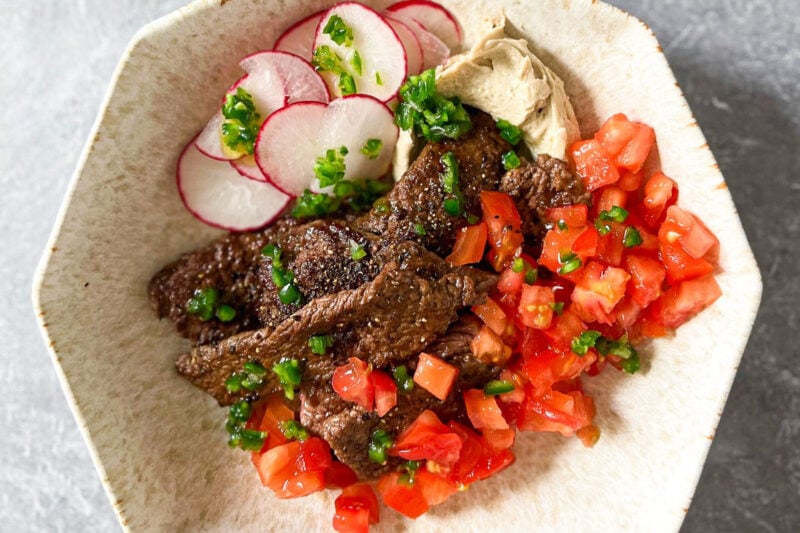Image courtesy DrHyman.com.
As a registered dietitian nutritionist, one of the topics people ask me about most often is fat. Is it healthy? How much is optimal? Which type is best? It’s complex to navigate, and public health recommendations and research continue to evolve.
For years, fat was vilified and blamed for rising rates of obesity and chronic diseases, but there’s a growing body of evidence refuting these associations. It’s now clear that fats are an essential part of a healthy diet. The 2015-2020 Dietary Guidelines for Americans removed the upper limit on total dietary fat, with the expert report concluding, “Reducing total fat (replacing total fat with overall carbohydrates) does not lower CVD [cardiovascular disease] risk … Dietary advice should put the emphasis on optimizing types of dietary fat and not reducing total fat.”
Although pretty much everyone can agree that we should avoid trans fat, other types are more controversial. The debate remains fierce around plant and seed oils, which are high in polyunsaturated fat, and saturated fat remains divisive. The 2020-2025 Dietary Guidelines for Americans still recommend keeping saturated fat under 10% of total daily calories. However, many experts claim that the evidence no longer supports limiting saturated fat to support cardiovascular health and longevity, as doing so may lower total LDL cholesterol but not necessarily the type of LDL particles primarily responsible for increased cardiovascular risk. With so much conflicting information, it’s no wonder people are confused.
Fat, like other nutrients, affects people differently depending on factors such as genetics, lifestyle, and overall dietary composition. In my clinical practice, my job is to help people understand the variables that might influence their response to dietary fat so that they can make informed decisions about their health. I recommend my clients consider the following when thinking about fat intake:
Five Things to Consider When Thinking About Fat Intake
1. Whole versus processed foods
Fat doesn’t exist in foods in isolation; the health impact will depend on the entire package. For example, research has shown differing effects of red meat and processed meat (both typically high in saturated fat) on cancer, cardiovascular disease, and all-cause mortality, with processed meat generally conferring a higher risk than unprocessed. This may be partly due to the preservatives, such as nitrates and sodium, added to processed meat. It is worth pointing out here that the jury is still out on how much red meat can be included in a healthy diet. As Levels advisor Dr. Mark Hyman says, we need more studies that examine moderate intake of non-industrial meat in the context of a high-fiber, low-sugar, micronutrient-rich diet. I’m a big proponent of mindful eating and believe you can enjoy almost any food in moderation if it contains quality ingredients and minimal additives. I guide my clients towards whole foods and away from processed foods as much as possible.
2. Energy intake and weight goals
Many of my clients initially worry that eating too much fat will make them gain weight. At 9 kcal/gram, fat has more calories than carbohydrates or protein (both of which have 4 kcal/gram), so it’s helpful to keep this in mind when considering how much you’re eating overall. A low-fat diet can be an effective weight loss strategy for some if they replace fat with protein and complex carbohydrates (e.g., fruit, vegetables, and whole grains). However, if they swap fat for refined carbohydrates, this strategy could backfire. According to one theory known as the carbohydrate-insulin model of obesity, foods that cause a blood glucose and insulin spike may increase hunger and cause your body to store more fat. I’ve seen clients successfully manage their weight with low-fat and low-carb diets, as long as the foods they include are nutrient-dense and minimally processed. Your optimum macronutrient ratios for health and weight management will vary depending on your unique physiology. Levels can help you measure your glucose responses, lipids, and other essential biomarkers and track your macros to ensure you hit your targets.
3. Omega-3 fatty acid intake
Omega-3 fatty acids help to reduce inflammation and promote metabolic health. The typical Western diet provides a ratio of omega-6 to omega-3 fatty acids in the range of approximately 16:1 to 20:1, mainly due to processed food intake. Some experts posit that this ratio should be closer to 4:1 and that overconsumption of omega-6 fatty acids may contribute to low-grade inflammation and increase the risk of autoimmune conditions, allergies, and mood disorders. Although vegetable and seed oils such as canola oil, soybean oil, and sunflower oil have sometimes gotten a bad rap due to their high omega-6 fatty acid content, some researchers now claim that omega-6 fatty acids are not only safe but can be cardiovascularly protective, particularly in the setting of adequate omega-3 fatty acid intake. Regardless of where you stand on seed oils, it’s generally a good idea to try to get more omega-3s; I encourage my clients to increase their intake from foods such as fatty fish, flax seeds, chia seeds, and walnuts. You can also get them from certain fortified foods or take a high-quality supplement.
4. The food matrix effect
Your body processes nutrients differently depending on the form of the food, a phenomenon known as the food matrix effect. Research has shown that people tend to absorb more fat from ground almonds than whole almonds, for example. This is because the fat in whole almonds is protected by sturdy cell walls that are broken down during grinding, making it more accessible to the body. The food matrix effect also has implications for satiety; for example, yogurt and cheese are generally more satiating than milk. I help my clients use this information when struggling with cravings. The food matrix effect also means that different forms of a food uniquely impact metabolic health; a recent review found that yogurt, cheese, milk, and butter had varying effects on biomarkers such as insulin, cholesterol, and triglycerides. These effects may differ depending on factors such as an individual’s age, sex, and lifestyle. More research is needed to ascertain disease risk, but this is undoubtedly an area that we’ll be keeping an eye on in the field of personalized nutrition.
5. Conditions affecting fat tolerance
In my clinical practice, I often see people with illnesses that make it difficult for them to digest fat, such as pancreatitis and liver disease. Other conditions that can lead to fat malabsorption include (but are not limited to) Crohn’s disease, celiac disease, small bacterial bowel overgrowth (SIBO), and alcohol use disorder. Undigested fat excreted in stool is called steatorrhea and, if ongoing, is often accompanied by gastric discomfort, weight loss, and nutrient deficiencies. If you’re experiencing steatorrhea, you may want to consume more medium-chain triglycerides (MCTs) from fats such as coconut oil, which rely less on pancreatic enzymes to break them down than long-chain fats such as olive oil. Using pancreatic enzyme supplements can also help. Work with your doctor or registered dietitian to address the root cause and manage your symptoms.
The relationship between fat and health is complex, so many nutrition professionals avoid blanket recommendations. However, there are some key points that most of us can agree on—namely, that whole foods are best, fruits and vegetables are important, and nutrition is personal. “First and foremost, I believe the quality of the fat we’re consuming is more important than the exact quantity of fat,” says Natalie Ledesma, a registered dietitian nutritionist specializing in oncology nutrition and digestive health. “I would certainly favor a higher-fat diet rich in plant fats such as olive oil, avocados, nuts & seeds over a low-fat diet rich in processed foods. Additionally, whenever possible, I like to make my recommendations based on one’s personal biochemistry. An individual who struggles with carbohydrate metabolism (as seen by their levels of hemoglobin A1C and insulin) may fare better with a higher fat diet than an individual who doesn’t have those same challenges.”
Best Sources of Healthy Fat
Some of my favorite healthy fat sources are salmon, walnuts, almonds, flax seeds, pumpkin seeds, avocado, eggs, tofu, dark chocolate (I like Hu), chia seeds, and olive oil. I include these foods in my diet weekly, if not daily. A typical day of eating for me might look like the following: an egg bite and low-carb toast topped with avocado and beets for breakfast, a tofu stir fry for lunch, baked salmon and vegetables for dinner, and nutrient-dense cookies made with quinoa, chia seeds, hemp seeds, pumpkin seeds, and tahini for dessert. Certain staples (e.g. bread/crackers, hummus, and nut milk) are easy and low-cost to make at home, and you can batch cook for quick freezer meals. Below are more recipes that you can follow to incorporate healthy fats into your diet:
Breakfast
- Smoked salmon avocado toast with flax bread
- Cucumber avocado kale apple smoothie
- Baby spinach frittata with sweet potato hash crust
- Crunchy seed porridge with blackberry compote
- Grain-free granola with Greek yogurt
Lunch
- Quick salmon citrus salad
- Zucchini noodles with pesto and avocado
- Tuna salad lettuce wraps
- Chickpea and quinoa salad with avocado, toasted pumpkin seeds, and lemon tahini dressing
- Greek grilled chicken salad
Dinner
- Vegan tofu noodles with almond butter
- Almond-flax crusted chicken
- Minute steak with tahini sauce
- Coconut veggie stir fry with cauliflower rice
- Olive oil-braised chickpeas with broccoli rabe
Snacks
- Matcha chia seed pudding
- Endurance crackers
- Dark chocolate-covered walnuts
- Roasted edamame
- Greek yogurt veggie dip
Final Thoughts
Fats are an essential part of a healthy diet, but quality matters. Research is ongoing to elucidate associations between fat types and disease outcomes, and optimal intake differs from person to person. Eating fewer processed foods and considering overall energy intake (with exercise as part of the equation) will help you consume fats in a way that supports your metabolic health.
 Learn how your body responds to your diet
Learn how your body responds to your diet
The best way to understand what habits and foods help you achieve balanced blood sugar is with a continuous glucose monitor and an app like Levels to help you interpret the data. Levels members get access to the most advanced CGMs and personalized guidance to build healthy, sustainable habits. Click here to learn more about Levels.








